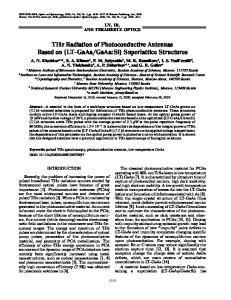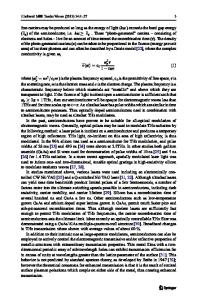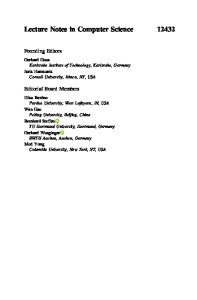A Photoconductive THz Detector Based on a Superlattice Heterostructure with Plasmonic Amplification
- PDF / 715,613 Bytes
- 5 Pages / 612 x 792 pts (letter) Page_size
- 8 Downloads / 260 Views
oconductive THz Detector Based on a Superlattice Heterostructure with Plasmonic Amplification A. V. Gorbatovaa*, D. I. Khusyainova, A. E. Yachmenevb, R. A. Khabibullinb, D. S. Ponomarevb, A. M. Buryakova, and E. D. Mishinaa a MIREA—Russian
b
Technological University, Moscow, 119454 Russia V.G. Mokerov Institute of Ultra High Frequency Semiconductor Electronics of the Russian Academy of Sciences, Moscow, 117105 Russia *e-mail: [email protected] Received June 30, 2020; revised July 29, 2020; accepted July 29, 2020
Abstract—A highly sensitive terahertz (THz) detector based on a photoconductive antenna (PCA) with plasmonic amplification on the basis of an InGaAs/InAlAs superlattice heterostructure is proposed. A noticeable increase in the photocurrent recorded by a plasmonic PCA detector and the signal-to-noise ratio was experimentally detected compared to the same parameters for the PCA detector without plasmonic electrodes. The efficiency of plasmonic electrodes has been experimentally confirmed by pulsed THz spectroscopy by measuring the dependence of the detector’s THz signal amplitude on the polarization of the incident pump laser radiation. Keywords: photoconductive antenna, terahertz detector, superlattice, InGaAs/InAlAs, plasmon array, plasmonic electrodes. DOI: 10.1134/S1063785020110218
Photoconductive antennas (PCAs) are among the most common sources and detectors of broadband terahertz (THz) radiation in THz spectroscopy and imaging systems. However, currently commercially available PCAs still have low efficiency of optical-THz conversion. The efficiency of the PCA is determined by both the properties of the photoconductive layer [1–3] and the geometry of the electrodes [4]. Most commercial antennas are made on the basis of a GaAs or InGaAs [5]. Unlike GaAs, InGaAs alloy is able to operate efficiently over a wider wavelength range (up to 1.5 μm).This is important for simplifying and reducing the cost of THz radiation generation and detection systems based on PCAs. The layers of unalloyed InGaAs have very low resistivity and high lifetimes of photoexcited charge carriers, which limits the use of this material as a base material for PCAs. To improve both characteristics, various methods are used, including growing InGaAs films at a low temperature with subsequent compensatory doping [6, 7], ion implantation [8, 9], doping films with iron atoms [1, 10], irradiation with high-energy bromine ions [11], and creating ErAs/InGaAs superlattice structures [12] with self-conductivity compensation, as well as using both lattice-matched [13, 14] and elasticstressed [15] InGaAs/InAlAs superlattice structures. Due to the high efficiency of PCAs based on superlattice InGaAs/InAlAs heterostructures [14], they have
become widely used for the production of antennas. From the point of view of increasing the PCA conversion, the most effective method is to create a metasurface in the gap between the antenna electrodes. Such a metasurface can be either separately dispersed elements (islands, quantum dots, etc.) in th
Data Loading...










